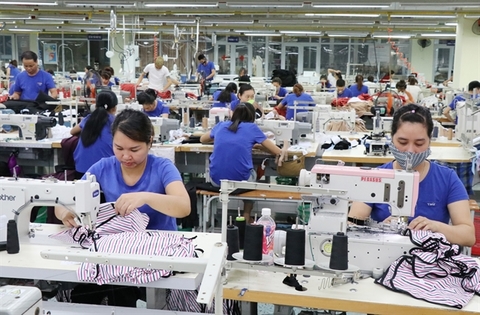
Workers at the TNG Thai Nguyen Investment and Trading JSC produce garments for export. Viet Nam’s textile export value rose almost 9 per cent in eight months of this year. — VNA/VNS Photo Hoang Nguyen
Viet Nam Textile and Apparel Association (Vitas) said the total export value of textiles, fiber, and cloth reached US$25.7 billion in the first 8 months of the year, up 8.6 per cent year on year, including 60.6 per cent from foreign direct investment (FDI) enterprises.
The textile and garment industry spent $14.9 billion to import textile and garment materials for production, up 2.3 per cent year on year, including 62 per cent from FDI enterprises.
The industry’s trade surplus in the first eight months reached $10.8 billion.
According to the Ministry of Industry and Trade, domestic textile enterprises face many challenges in production and business activities.
The US-China trade war has affected exchange rates, leading to higher prices of processed goods in Viet Nam compared to regional competitors such as South Korea and China. That has also affected the number of export orders for local enterprises.
In the first eight months of this year, textile production and exports have grown over the same period last year, but due to changing orders, local businesses need to have solutions for production and business.
Industry experts said export orders have fallen. Some businesses have only received 70 per cent of new orders against the same period in 2018.
Consumption of fibres and raw materials has struggled as Viet Nam's major export market –China (accounting for 60 per cent) – has cut import volume. Garment enterprises also saw a drop in orders.
In 2018, many large enterprises in the industry had export orders throughout the year, while this year, they could only sign monthly export contracts with small volume. Buyers are concerned the US-China trade war will escalate, so orders are broken up instead of in bulk.
Phi Viet Trinh, General Director of Ho Guom Garment Group said the firm's orders have fallen against the same period last year. But there are still enough jobs for workers. It expects by year-end, orders will increase because demand is higher in the last months of the year.
No benefit
As the third quarter comes to an end, it is unlikely that Vietnamese textile enterprises will increase exports due to the on-going US-China trade war as some previously predicted.
In the textile and garment industry, enterprises from South Korea and Taiwan in Viet Nam have gained advantages from the trade war because they own production factories under the value chain.
“Korean textile and apparel companies in Viet Nam are the biggest beneficiaries of the trade war. This country’s 143 enterprises account for about 50 per cent of Viet Nam's textile and apparel export value to the US,” FiinGroup, a financial and business information provider in Viet Nam, was quoted by the Dau Tu (Investment) newspaper as saying.
Viet Nam has not seen investment flows to the textile and garment industry due to the US-China trade war, according to the Viet Nam Textile and Garment Group (Vinatex). There have not been significant shift in production from China to Viet Nam.
The investment from a country to another depends on many factors, said a Vinatex leader.
Nguyen Thi Thu Trang, Director of the WTO Centre under the Viet Nam Chamber of Commerce and Industry – VCCI, said Viet Nam has not benefited from the trade war as many forecasted, including the moving investment from China to Viet Nam.
Another problem is that although the export turnover is large, the domestic textile and garment industry still lacks input materials. It has to import all cotton and 80 per cent of fabric and other material from China and India so the product costs of domestic firms are much higher than FDI companies, she said.
Therefore, if local firms have increased garment exports, textile companies of China and India would benefit, because the local firms have to increase their imports of raw materials. — VNS